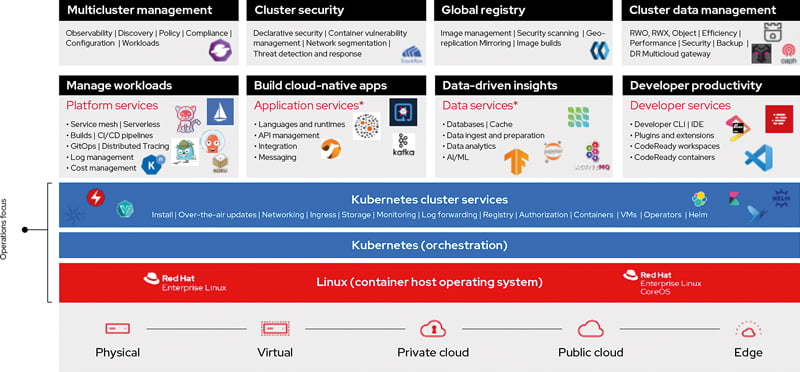SAP modernization continues to gain momentum


Digital transformation
SAP service partners can adequately support companies in establishing such target architectures and thus tap into new revenue streams.
In many companies, the modernization of the SAP landscape and thus the strengthening of innovative power have taken on a high priority in the last twelve months. Open source plays an important role here, and its use continued to grow dynamically last year. This is also a key finding of Red Hat's "The State of Enterprise Open Source 2022" study, in which almost 1,300 IT executives worldwide took part. Infrastructure modernization is a key driver for open source adoption for 62 percent. In addition, 54 percent cite digital transformation, 52 percent application development and 48 percent application modernization.
The increased use of open source also corresponds to the growing importance of new technologies. 80 percent of companies plan to use open source in areas such as AI (artificial intelligence), ML (machine learning), edge computing or IoT (Internet of Things). The survey also shows that open source software is no longer seen primarily as a cost-effective alternative to proprietary software, as it was in earlier years. Instead, when asked about the relevant factors for use, better security and higher software quality are named by 32 percent each.

This trend toward the increasing importance of open source is particularly evident in the SAP area. Open source has long since ceased to be experimental in nature and is now a tried-and-tested strategy. For some time now, SAP itself has been increasingly pursuing the open source path, as evidenced by SAP cloud offerings, Linux as the sole operating system for SAP HANA, and the new SAP LinuxLab initiative on the topic of SAP automation. In order to integrate innovations and new end-to-end processes with SAP and migrate ABAP in-house developments, open source and the agile use of modern cloudnative development models are important components.
Especially with regard to non-SAP environments and new technologies or development and deployment models, open source is a key success factor and the innovation driver par excellence. Examples are cloud, containers, microservices and edge computing, Industry 4.0 and IoT, Big Data and Data Analytics or AI and ML. And the use of such operating models, architectures and technologies is also an absolute must for SAP users in today's world. For example, they are the basis for innovative factory edge implementations, where real-time integration of data into SAP systems takes place. Another example from the energy supply sector is the millions of smart meter data that are managed, analyzed and pre-processed in the cloud before they then flow into SAP core processes.

The open source relevance for SAP partners
The increased use of new technologies and the growing importance of open source affect not only SAP and SAP users, but also SAP partners, and not just the large ones, but especially the small and medium-sized ones with a local presence. After all, their role is of central importance for many SAP users. Not for nothing, for example, does SAP say: "For some, especially small and medium-sized companies, working directly with a large company like SAP is not practical. It's easy to understand that you gain numerous benefits from working with a close partner because they know your home market, speak your language, and are familiar with your culture and laws and regulations."
For SAP partners, this development raises the question of how they can best go down the open source path. There are some basic prerequisites and important measures for this. At first glance, open source can seem daunting to potential users. The reason is the diversity of projects with thousands of frameworks or tools. However, open source does not mean that a user has to assemble and maintain everything himself. Particularly with regard to the infrastructure and technology base, "enterprise-ready" solutions are available that include coordinated, hardened and certified software - in combination with support and SLAs (service level agreements). Of course, an SAP partner in the open source sector also needs solid expertise. Here he can draw on the training offerings of open source specialists, for example with regard to the containerization of specialist applications and backend services.
In addition, successful open source use also requires expertise in areas such as agile working, methodology or error culture. In addition, the partners also support the so-called open source policies, which aim to optimize the use of open source and minimize all technical, legal or business risks. Concrete examples and templates for an open source policy are available on GitHub, for example. Last but not least, SAP partners can also benefit from the new open source initiative of SAP LinuxLab, which simplifies the automated creation and management of SAP environments. This is based on unified and modular codes and tools that are continuously developed and provided by SAP technology partners. These include Red Hat, Suse, IBM and SVA. The SAP LinuxLab offering covers a broad spectrum of SAP-specific tasks: from SAP-certified infrastructure and SAP installation to SAP sizing and operation. SAP partners can save costs and time by using it, thus gaining the freedom to design and sell their own value-added services.
The hybrid cloud as the optimal target architecture
In addition to open source, the cloud will also have a greater impact on the SAP world in the future. Hybrid cloud models in particular, which link on-premises and off-premises resources, will gain in relevance. Companies will benefit from the scalability of a public cloud on the one hand and the flexibility of a private cloud with regard to the implementation of internal or regulatory requirements in the areas of security, data storage and processing on the other. The fact that the cloud is playing an increasingly important role is demonstrated even by the previously rather reserved public sector. One example of this is the VS(classified information) cloud. Secunet, IBM and Red Hat are designing a cloud solution based on security technology "Made in Germany", enterprise open source software and professional services. The companies intend to provide the first highly secure cloud solution on the German market for use with classified information classified VS-NfD (Classified Information - For Official Use Only). This will provide crucial support for the activities of the public sector with regard to digital sovereignty.
Hybrid cloud platforms are also increasingly used in the SAP world. For example, SAP business applications are being containerized and the SAP ecosystem is modernizing towards cloud architectures. SAP users will increasingly rely on a mix of on-premises, private and public cloud services - not only for SAP but also for non-SAP workloads.
In terms of SAP solutions, on-premises environments will continue to be justified. This is also indicated by the DSAG Investment Report 2022. Currently, 32 percent of the companies surveyed use S/4HANA primarily on-premises, partly because cybersecurity plays a decisive role for the companies. In the report, DSAG calls for SAP landscapes: "There is a need for high-quality software and cloud solutions that meet the increased operational and security requirements, as well as provide a functional equivalent to previous on-premises solutions."
Cloud agnostic through Red Hat OpenShift
In this context, many SAP users and partners are not yet sufficiently aware of what Red Hat OpenShift offers. It is an enterprise Kubernetes platform for designing, automating, scaling and managing container-based applications. In doing so, it supports development on any infrastructure, meaning a hybrid multi-cloud mix including on-premises deployments. Red Hat OpenShift is also approved for running SAP workloads such as SAP Data Intelligence. There is platform independence, so vendor lock-in in terms of cloud provider is avoided. This means that Red Hat OpenShift acts as a kind of abstraction and integration layer for Hyperscaler platforms with their native services as well as the SAP-BTP (Business Technology Platform) environment. Users thus have a uniform development environment with open source technologies at their disposal, so that SAP programmers can also easily enter the worlds of Continuous Integration, Continuous Delivery and Continuous Deployment as well as DevSecOps or Pipelining.
The platform contains all the necessary functions and services to operate a container management platform for mission-critical applications on different infrastructures in a certified manner. This includes aspects such as SLAs, multiple security layers, automation, and cluster management. For example, users can move containerized applications between clouds while maintaining functionality with Red Hat OpenShift as the foundation. The platform is now also available as a fully managed cloud service on all leading public clouds or as self-managed software for enterprises. In terms of security and functionality, Red Hat OpenShift thus fulfills a key DSAG requirement. And the platform ensures that companies retain their strategic flexibility.
Importantly, Red Hat Open Shift offers much more than Kubernetes. Kubernetes orchestrates and automates the operation of Linux containers and eliminates many of the manual processes required to deploy and scale containerized applications. However, Kubernetes alone cannot address all the challenges associated with mission-critical workloads. Tools and services that cover the following areas, among others: registry, network, storage, metrics, monitoring, authentication and authorization - and last but not least security - are also indispensable. And it is precisely this complete package that Red Hat OpenShift delivers.
An enterprise Kubernetes platform like Red Hat OpenShift and its associated open source infrastructure and software ecosystem can also address a key problem in today's IT environments: the IT silos that continue to hinder enterprises in designing IT infrastructure that is flexible and forward-looking. A hybrid cloud architecture and an open source ecosystem create a unified technical foundation that supports seamless, cross-hyperscale connection of existing and new applications and services. IT silos are thus dissolved and no new ones are created. It also bridges the gap between SAP systems and non-SAP applications, driving automation across the entire process landscape.
The end-to-end automation of processes, even across classic IT boundaries, is ultimately the goal, as evidenced by a large number of tenders and central IT projects in 2022. Companies can thus reduce administrative effort, eliminate potential sources of error due to manual activities, and eliminate repetitive tasks. Last but not least, automated workflow management also leads to significant cost reductions in many cases.
Enterprises deploying critical systems in open hybrid cloud environments need a reliable operating system that is tested and validated on all platforms. Red Hat Enter-prise Linux already serves as a trusted backbone for many of the global Fortune 500 companies, as well as the foundation for SAP infrastructures.
Overall, SAP applications have long since ceased to be isolated systems adapted to specific requirements. Open source-based hybrid cloud platforms, cloudnative development models, integrated end-to-end architectures, and automation technologies are the key to success in modernization and
digital transformation. SAP users can migrate their own ABAP developments and integrate new processes with SAP. Last but not least, they gain maximum strategic flexibility through cloud-agnostic multi-hybrid cloud use - in line with the guiding principle "Develop once - deploy anywhere".





